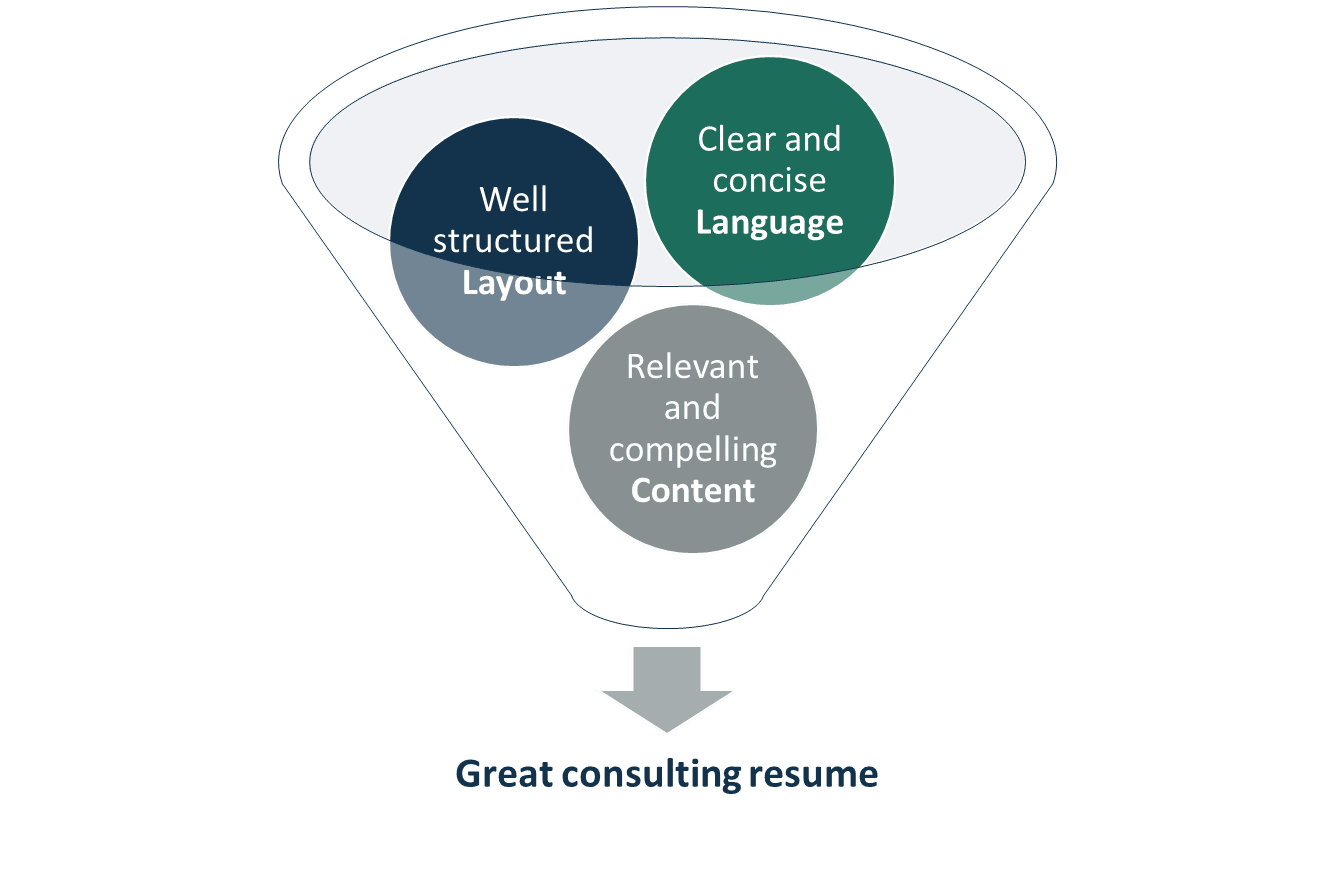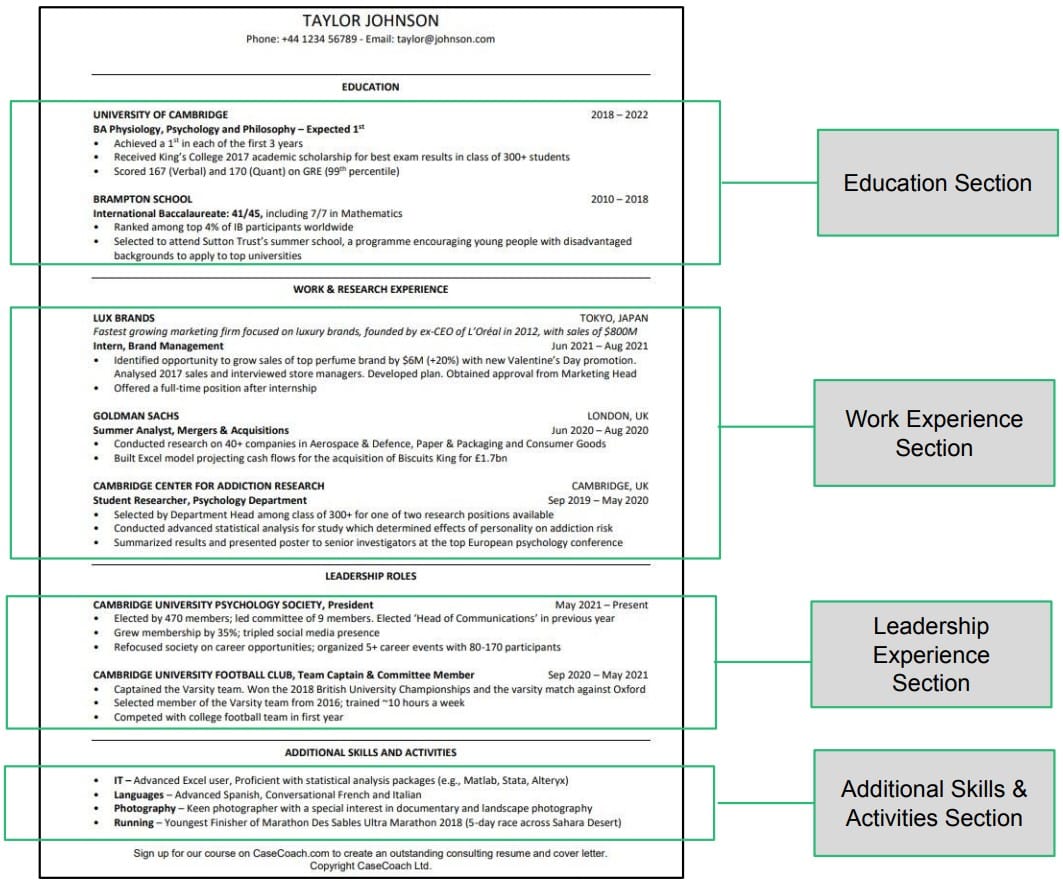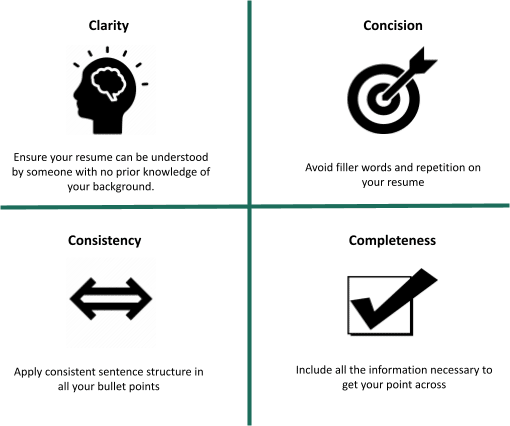How top consulting firms select candidates to interview
Overall, 90% of student applicants and experienced professionals are rejected at the initial screening stage of top firms such as Bain, BCG, or McKinsey, and the smaller strategy firms. Even if you’re studying at a top university, there is no guarantee that you will be invited to an interview. But your chances don’t have to be so slim.
This article will cover Resume and Cover letter advice for Undergraduate students, MBA graduates, and Experienced Professionals and show you exactly how to write a compelling resume that will significantly improve your odds of passing the initial screening stage.
You’ll find templates and examples of successful resumes and cover letters in CaseCoach’s Resume Courses for students, MBA candidates, and experienced professionals. The courses provide the inside scoop on what it takes to get through the first round of the recruitment process at top consulting firms to be one of the top 10% invited to interview.
Key Takeaways:
- Given that the majority (~90%) of applications to top consulting firms never make it past the resume and cover letter screening stage, it is essential to invest in getting both right.
- Students and MBA candidates are more likely to make it past application screening if they attend a core school where top firms do most of their hiring. Applicants from target and regional schools can make it past screening as well, but with much more effort than a core school student. Applicants from non-target schools have very little chance of making it past application screening.
- When applying to a firm, you can maximize your chances by picking an office that is not the most selective and where you have a strong connection as your first choice. Reach out to specific practices for specialist roles if it aligns with your experience.
- To create a convincing resume, you need the right layout, content, and language. A great resume layout has good formatting and structure. Great content in a resume means clearly demonstrating your academic and numerical ability, stand-out work experience, people skills, and a track record of impact. Great language in a resume means all text is clear, concise, complete, and consistent.
- As with resumes, a great consulting cover letter also has the right layout, content, and language. It should ideally contain four sections: an introduction of yourself, what you bring to the role, your motivation, and finally, a quick wrap-up.
- CaseCoach’s Free Resume Courses provide detailed and specialized advice for students, MBAs, and experienced professionals as well as resume and cover letter templates to help you craft a successful resume and cover letter.
How application screening works
Application screening typically happens in three steps – Initial screening, Secondary screening, and Final screening/invitations. However, this process varies significantly across firms, offices, and practice areas.
Initial Screening
The screening process usually starts with a junior recruiter downloading the applications from their system.
- They filter and dispatch the applications to the right screening team.
- They eliminate any candidates that don’t study target degrees at target universities.
Obviously, given the volume of applications, the recruiter only has the time to quickly glance at each resume. That’s how 80% of the applications will be eliminated. So, if your resume is unclear or doesn’t immediately show what the recruiter is looking for, you’re out.
Secondary Screening
The second task is establishing a short list of high-potential candidates. That call can be made by the university recruiting team for students, the office recruiting team for MBAs, or by consultants who are part of the recruiting team for experienced professionals.
- They screen every resume, generally in less than a minute. They sometimes calculate resume scores, assigning points to specific universities, degrees, internships and extracurriculars, and use the total score to rank the resumes.
- They will also look at any previous interviews with the firm. If it was a disaster, you’re unlikely to be invited again. If your interview is recent, let’s say less than two years, you’re unlikely to be invited unless you reached the final round, and the firm has ambitious recruiting targets for the year.
- They will also consider references:
- This is also when the result of a problem-solving test may be incorporated.
Final Screening/Invitations
The final step is deciding who will get that coveted invitation. The decision is often made by the leader of the university team (undergraduate hiring) or by the head of on-campus recruiting for the office (undergraduate/MBA hiring) or by a senior recruiter/consultant (experienced professional hiring).
- They’ll decide based on the same elements as the initial screening.
- Applicants that were top ranked at the previous stage are almost certain to make the cut.
- But for others, additional criteria may be considered. For students/MBAs, the team might seek the input of the campus team:
- They might look at the cover letter. And might, as well, bump up candidates who have been referred by alumni of the firms.
- They may also alter the mix of candidates to ensure that diversity targets are met.
The role of schools in screening decisions
Consulting firms and recruiters have three categories of universities when evaluating an application: Core, Target, and Non-Target Universities. The university category an applicant belongs to significantly affects their odds of passing the initial screening stage.
Core universities
Core universities are the big-name universities where the top firms get most of their candidates. If you study at one of these and are enrolled in the right degree, you have as high as a 50% chance of getting invited to interview. But of course, these odds will vary a lot by degree.
Top firms invest quite a bit in their recruiting efforts at these universities. They generally have a dedicated campus team composed of recruiters and consultants who are alumni of that university. You will often see these individuals on campus.
They do coffee chats, recruiting events, and they also screen applications. They know all about the university: which degrees are more selective, which societies are the most prestigious. So, they are well placed to identify the candidates with the highest potential.
Target universities
Target universities are different. These are the universities where top firms regularly source candidates but make only a small number of hires in a typical year. If you’re an applicant from one of those universities, you might be invited to interview, but the odds are significantly lower than at a core school.
Firms don’t invest a lot of resources into those universities. They don’t have dedicated campus teams for each school and don’t organize many recruiting events. Instead, they generally have one team covering a number of target universities. This team will oversee screening the applications. So, although your odds will be lower than if you studied at a core university, your application will still be screened.
That being said, some target universities might still be considered as a core source of candidates by regional offices. Students at these universities will have a higher chance of being invited to interview if they apply to the local office of the firm.
Non-target universities
The last category is non-target universities. These are the universities that don’t typically place students at the top firms. The disheartening news is that if you’re studying at a non-target university, your application is not likely to be screened.
| Core |  |
|
| Target | Non-target |
Our application tips to maximize your chances
This section addresses how to think of three core elements of your application to a top consulting firm – your choice of office, applying as a generalist vs specialist, and how to improve your odds of scoring an interview with networking.
Choosing the right office
The official message from consulting firms is that they hire anyone that meets the bar, and that the bar is the same across offices. However, your choice of office could tilt your odds of passing the screening stage negatively or positively and three factors come into play:
- The selectivity of an office depends on how ambitious its recruitment targets are, and how many applications they receive each year. Locations with low targets and a high number of candidates will be more selective than the others. In general, English-speaking offices in attractive locations, such as New York, Boston, San Francisco, and London are among the most selective. While offices with a language requirement have a smaller pool of applicants to choose from.
- Second, you need to consider your connection to the location. Offices are reluctant to hire candidates who are likely to ask for a transfer after a year. They need to believe that you are committed to their location. This will be the case if you apply to offices in your home country, that are focused on the industry where you are experienced, or where you have worked or studied.
- Third, you need to consider how your weighting will be perceived. Offices will see your order of preference and are unlikely to invite you if you did not put them as your first or second choice. Nobody likes to be a plan B!
Overall, if getting an interview somewhere matters to you more than working in a specific location, we recommend that you hedge your bets a little bit. Pick an office that is not the most selective and where you have a strong connection as your first choice.
Choosing between generalist and specialist roles
Although consulting firms have historically hired candidates for generalist roles, they are increasingly looking at hiring for specialized practice roles. This trend is driven by increasing client demand requiring expertise in areas like operations, data science, digital marketing, sustainability, capital markets, and life sciences.
It’s also a result of the Top 3 firms getting bigger and therefore getting involved in their client’s organization, sometimes in areas that require a deeper technical understanding. Consultants hired as experts are assigned to projects that are aligned with their expertise and will end up working on multiple types of problems within that industry, quickly becoming deep experts.
The responsibility for expert consultant recruitment falls into each firm’s practice areas. The challenge for candidates is that practice areas don’t normally have an on-campus presence and are not systematically involved in the resume screening process.
This means that the onus is on the candidate to identify the role on the firm’s website and to connect with recruiters or consultants within that practice and location ahead of submitting their application. These recruiters must be ready to scoop your application when it comes.
When applications are screened, the relevance of the candidate’s background for the role is critical. This means that you need to highlight in your resume and cover letter relevant experience and expertise — which would not be the case if you applied to a generalist role.
Improving your odds with networking
While networking will not make a difference in whether you get an offer once you’re invited to an interview, it can make a difference in the application screening stage of the process.
However, top consulting firms pride themselves on objectivity and fairness, thus referrals only factor into the interview invite decision process when the fundamentals of an application put the decision on the fence. As such, your first priority should be preparing an outstanding application (resume and cover letter).
Networking is similar across the board for undergraduate students, MBA candidates, and experienced professionals. However, experienced professionals might have to put in more work networking as they lack the structured opportunities offered at MBAs and universities.
There are three things you can do to boost your chances with networking:
- The first one is to connect with members of the team that lead the firm’s recruitment at your university, for instance during a coffee chat or a recruitment event. If you leave a positive impression, this will be considered at screening. This can also prevent your resume from being overlooked. On top of this, conversations can help you learn more about the firm and its recruiting needs, and to apply for the best role at the best time to maximize your chances.
- The second way is to get referred by former consultants who know you well, for instance, classmates who have completed an internship at the firm. They should be able to email the recruiter that oversees the screening of your application.
- Finally, and this is a real trump card, if you know a partner or a senior client personally, they might be able to put in a request for you to be interviewed. And normally, the firms will do them the courtesy.
Overall, while referrals can make a difference at the application screening stage of the process, be careful because this works both ways. Leaving a bad impression or getting a negative referral could easily derail your application. So only corral referrals if you think they’re going to be positive.
Writing a great consulting resume
Your resume can make a resounding difference in how your application is received by the consulting recruiter, hence building a compelling consulting resume can improve your odds of getting invited for an interview.
There are three building blocks needed to create a convincing resume – the right layout, the right content, and the right language:
- The first building block is the layout. Remember, the firm is going to make their decision based on a quick screening of your resume. So, you need to present a clean and professional format that’s well-structured and highlights your best experiences.
- Second, you need to have the right content. At some point, they are going to look at your experiences in more detail. And you want to give evidence that you possess all the attributes they are looking for.
- Thirdly, language: you need to write in a clear and concise manner. You don’t have a lot of space. And the language needs to be consistent and say enough to explain your experiences.

In the following sections, we will describe in detail how to build your resume with the right layout, the right content, and the right language. This will take some work, the input of multiple people, and several drafts.
Additionally, CaseCoach’s Free Resume Courses for students, MBA candidates, and experienced professionals provide insights on how to format and structure your resume, what experiences are worth highlighting on your resume, and the best way to communicate these experiences in your resume. CaseCoach also offers coaching services from a number of former interviewers at McKinsey, BCG, Bain, Big-4s, and other firms who can give detailed feedback and partner with you in crafting your ideal consulting resume.
Get the layout right
Consulting recruiters screen resumes very quickly, hence it is important to immediately demonstrate what the recruiter is looking for, with the right layout. The layout can be broken down into 2 sections: the format and the structure.
Get the format right
There are three formatting qualities of a great consulting resume:
- First, it needs to be clean and professional. What this means is no logos, no pictures, no graphs, and no emojis. Use a plain white background and a black, conservative font – there should be no color. Make sure that all titles and paragraphs are vertically aligned. And use only one font, with no more than a couple of different sizes. Avoid underlining, and only use bold and italics sporadically.
- Second, your resume needs to be short. For a student applicant, there is no good reason to go beyond one page. But two pages is not necessarily a problem, particularly for candidates who have had more than three jobs after graduation. More than two pages, however, is a no-go, regardless of your background.
- Third, you need to use formatting to make specific sections visible. You should have clear and consistent breaks between sections and jobs. Similar elements, such as degrees, job titles, employers, or dates, should have a consistent format throughout the resume. This way, they will be easy to identify.
- The first one is through teamwork and leadership experience. Here, you want to show that you have a track record of taking initiatives, leading others, and achieving outstanding results. For instance, you might have been a member of a sports team or of a committee, elected to lead a team, or had important responsibilities at work or in your extracurriculars. Another typical evidence is founding an organization. This can be a business, a club, or any other initiative at work or in your extracurriculars.
- Another way to demonstrate this is to share an experience of persuading others. For instance, you may have convinced reluctant clients or other senior stakeholders at work or at university. This could have resulted in making a sale, obtaining a budget, getting the go-ahead for an initiative, or influencing any other important decision.
- Finally, people skills can be demonstrated through communication abilities. Here, it could be because you have public speaking or debating experience, or your work involved in writing publications. The quality of your resume and your cover letter will be another indication of how good you are at communicating in a professional manner.
- The first one is that, in a resume, less is more. You should only include items that are impressive or necessary to understand your experience. The rest won’t give you extra points and will dilute your most impressive achievements. This also means that you should exclude less meaningful details or experiences, such as old and unimportant internships, and devote less space to your oldest experiences. Similarly, less impressive achievements should be removed. For instance, if you’re President of a large student society, it often doesn’t add much to highlight that you were a member of another.
- The second principle, which applies specifically to MBAs and experienced professionals, is to mind the gap. Any large gap in your experience will raise questions for the recruiter. Similarly, any dates that are overlapping in different sections of your resume can be confusing. So overall, demonstrate a clear timeline if you can.
- The final principle can be paraphrased by not saying you’re funny, but telling a joke instead. In other words, give evidence of your skills through your achievements rather than stating that you’re great at something. That means you should try and quantify your impact as much as possible.
- Let’s start with Clarity. Bear in mind that you need to be understood by someone who has no prior knowledge of your background. So, you’ll need to use everyday language with short familiar words, no lingo, or acronyms. Use concrete rather than abstract words, such as “car” instead of “vehicle”. Lastly, focus each bullet point on a single idea.
- The second C is Concision. The goal here is to limit each bullet point to two lines maximum. So, you’ll need to strip your resume of filler words and repetition. It’s important because recruiters are unlikely to read bullet points that are longer than two lines.
- Let’s move on to Completeness. What this means is that you need to include all the information necessary to get your point across. And sometimes, that means that a bit of context is required. It is also because of completeness that you should explain your employer, or your role, when it is not obvious.
- The final C is Consistency. Consistency is important so that your resume comes across as professional and is easy to understand. It means applying consistent sentence structure such as starting all bullet points with an active verb in the past tense. Similarly, always use the same punctuation to close bullet points.
Get the structure right
For student applicants, it is recommended your resume contains four sections in this order: First, education. Second, work and research experience. Third, leadership experience, And fourth, additional skills and activities.
For MBA candidates and experienced professionals, leadership roles aren’t a recommended section as it mainly serves as a differentiator among undergraduate students with similar academic backgrounds. Thus, it’ll be just 3 sections: education, work experience, and additional information.
You can customize these labels to reflect your own experiences. For instance, you might not have research experience or might want to highlight athletic achievements rather than leadership roles.
Experiences within a section should be in reverse chronological order, with the most recent at the top.
Education section
For the education section of your resume, start with a new header for each of the academic institutions where you’ve earned a degree. If you have earned several degrees at that university, you can nest these degrees within the same header. You should then include, as bullet points below the degree, your top, and most meaningful academic achievements. You don’t need to include all the classes you took or papers you wrote, they won’t give you extra points. If you can, include your expected graduation grade.
For MBA students and experienced professionals, it’s recommended that you group your academic, extracurricular, and leadership experience together in this section. This makes it easy for the recruiter to see that you not only did well academically, but you also did a lot outside of the classroom – which is impressive. However, student applicants shouldn’t include extra-curricular activities in their education section – they are very important, but belong somewhere else.
Work Experience section
To structure the work experience and research section of your resume, create a new header for each of your employers, as you did for academic institutions, and nest all the jobs that you’ve had with that employer within the same header. This way, if you were promoted several times within the same employer, you will be able to show this without repeating yourself. Now, if the employer or research center is not well known, then you should introduce it in a positive light.
The second principle is to apply a consistent structure to each of your roles. Start by explaining your role. What were your responsibilities, your objectives, and the scope of your work? This will help the recruiter understand what you did. Then use one or two bullet points, each highlighting a specific achievement. You should pick these achievements not only to show the impact that you’ve had but also the skills that you can bring to a consulting job.
Finally, whenever you can, use the last bullet point to summarize your performance in that role. For instance, state if you were offered a full-time position after your internship.
We’ll get into more detail later about which achievements you should pick, and how you should demonstrate top performance.
As for your academics, only include your most meaningful work experience. As a rule of thumb, include your latest internships and any job at a selective employer. And mention if you had a regular part-time or summer job during school or university. If you are a second-year MBA, include your MBA internships, but you may leave your undergraduate internships out.
Leadership Experience section
For undergraduate applicants, let’s discuss how you should present your leadership roles. Leadership roles are the main way firms differentiate candidates with similar academic backgrounds. You may have been involved in many teams, clubs, or societies, so the point is not to mention all of them. You should only focus on your 2 or 3 most impressive roles.
In structuring your leadership roles, you should create a new header for each of them, similar to the work experience section with bullet points to give more details. You may use the first bullet point to explain your role, and other bullet points to highlight specific achievements. These are important. Seeing as not everyone can be the captain or president of a society, what matters is what you’ve accomplished in your role.
Lastly, you may have been involved in the same organization in another capacity in previous years. You should mention this in one of the bullet points to give the recruiter a more complete picture of your experience.
Additional skills and activities section
Finally, let’s look at the additional skills and activities section of your resume. This section will typically include key extracurricular activities or interests that were not already mentioned in the “Leadership Roles” section, as well as skills useful to consulting, such as spoken languages and software packages.
For the activities, just mention two or three examples and describe each of them in a bullet point. It’s going to be more impactful than sharing a long list of activities without any details. This way you can catch the recruiters or interviewer’s attention with your most interesting and significant extracurriculars.
In this section, you can also include important information that doesn’t neatly fall into education or professional experience. For instance, your work permit status, or any certifications useful for the job.
By now, you should have a good view of what a strong resume layout looks like for a consulting application.
If your resume already fits that format, great. Just continue to use it. If it doesn’t, I suggest that you pick up a template provided in our Free Resume Courses and populate it with your academic institutions and degrees, your employers and roles, leadership experience (for student applicants), and other skills.

Get the content right
When consulting firms assess candidates, they look for certain qualities that indicate whether they want this candidate on their team. That’s a factor of whether the candidate can problem-solve, if they can get things done, and how they represent the firm. This is, of course, assessed in the interview and we cover this in great depth in our Consulting Interview Prep Toolkit.
However, this is also assessed when your resume is being screened. The first quality looked for is outstanding academics and numeracy. The second quality is relevant work experience and a track record of strong performance in these roles. The third quality is great people skills – any experience in interacting with others or communicating to large audiences is usually a good indication of that skill. The final quality is your impact, which can be demonstrated by taking initiative and making a difference in your team or organization. Of course, it’s okay to not stand out in all four dimensions if you stand out in some.
All of this should give you an idea of what kind of content to include in your resume. Additionally, CaseCoach’s Free Resume Courses for students, MBA candidates, and experienced professionals provide insights on selecting the right experiences that the top consulting firms are looking for, which will help you stand out during the application screening stage.
What to include
Academics and Numeracy
Let’s start with academics and numeracy. Top academics can be demonstrated by having selective degrees from top universities, as well as top grades, academic scholarships, or awards.
Numerical ability is also important, as this is used a lot on the job. The easiest way to demonstrate this is through quantitative degrees in science or engineering. But not having a quantitative degree is completely fine. In that case, it will help to show high test scores, such as the GRE or SAT, or work experience involving quantitative modeling.
Work Experience
The second key attribute that you want to demonstrate is stand-out work experience. For undergraduates, this can be demonstrated by getting a selective internship and performing well in that role. For MBAs and experienced professionals, consulting firms want to know they’re getting the best person in the best role from the best employer. Hence, the content included in the work experience section needs to prove that.
First, if your employer is not well known, you need to describe it in a positive light. Then, for your performance, sharing your performance rating if your employer provides one, an earlier promotion than the norm, being the youngest in your role, or maybe having an unusual scope of responsibilities signifies that you are a candidate worth seeing.
For experienced professionals applying for specialized roles e.g., in data science, operations, or technology, which require specific functional, sectorial, or technical knowledge, your resume must show that you have the right expertise. This can be demonstrated through degrees and qualifications, but more importantly, you’ll need to have experience in relevant roles or projects.
People Skills
The next attribute is people skills. Consulting is a client-facing job, where new hires are often called to interact with senior executives, and a team sport, where consultants work alongside colleagues and clients. This means that firms are looking for evidence of the ability to interact with others, in a mature way. There are several ways to demonstrate this.
Impact
The final attribute is impact. Do you have a track record of taking initiative, showing drive, and achieving? If you do, it’s a good sign that you have the potential to contribute to a team of consultants and make a difference. The main way you can demonstrate this is by giving evidence of outstanding results at work or in your extracurriculars. You need to make it obvious to the reader that those results were outstanding, for instance, by quantifying or benchmarking them.
In many cases, outstanding achievements come from extraordinary drive and initiative. You should try to demonstrate this as well.
Another great way to demonstrate this is having achieved high attainment despite a less privileged or disadvantaged background. Firms love candidates who have pulled themselves up by their bootstraps. If that’s your case, well done! Make sure to convey it in a subtle way.
Overall, there is an abundance of content that can be included in a resume. Hence, it’s worth spending the time really reflecting on your experiences and what you can bring to the table.
Get the content right – What not to include
There are three general principles to consider when writing a resume, to ensure that only relevant experiences that increase your odds of getting an interview, are included:
Get the language right
You should now have a solid working draft of your resume, with a clear and professional layout and the right content to impress. Now it’s time to wordsmith it all.
The framework we’re going to use for this is the four C’s of written communication: clarity, concision, completeness, and consistency. You’ll want your language to meet those four tests.
So, overall, remember the importance of the four Cs. Clarity, concision, completeness, and consistency. And make sure to proofread both grammar and spelling multiple times.

Writing a great consulting cover letter
Let’s discuss how to put together a cover letter as a student applicant, MBA candidate, or experienced professional. The first thing you need to know is that it’s not a big part of your application and you should not assume that it will be read.
So why should you spend time on it? Well, if it is read and it’s bad, you’re likely to be rejected because of it. However, it’s not because you’ve written a great cover letter that you’ll be invited to interview.
So, let’s look at what you want to achieve with your cover letter. Like the resume, there are two qualities that you need to pay attention to – the first is the format comprising the layout, content, and language and the second is the structure of the cover letter.
Formatting your cover letter – layout, content, and language
Layout: Keep the cover letter to one page. Apply a simple and professional format. Follow a clear and uncomplicated structure.
Content: You want to use the cover letter to explain why you’re applying for this role, firm and office, and what you have to offer. For MBA candidates or experienced professionals applying for a practice role focused on a specific industry or function, you need to explain why. In addition, you must be sure that what you say is relevant to the firm and the role. We’ve seen too many candidates copy and paste a cover letter and end up with something that doesn’t make sense for the role they’re applying for.
Language: Write in a professional tone, and ensure you check your grammar and spelling multiple times.
Structuring a cover letter
To structure your cover letter, it’s recommended that you keep it simple, with four sections. Start by introducing yourself, then explain what you bring to the role, thirdly, lay out your motivation, and finally, end with a quick wrap-up.
An ideal introduction would read: “I am writing to express my interest in joining Bain & Company as an Associate Consultant. I am currently completing my final year at Cambridge University, in a Bachelors of Arts in Physiology, Psychology, and Philosophy”. The introduction states the letter’s purpose and summarizes the candidate’s background.
Let’s move on to the second part of the letter, which explains what you bring to the role. This is the most important part of the cover letter. There are two ways to do this. The first is to state the top attributes that you bring to the role, and then illustrate each of them with an achievement. The other way is to summarize your journey and state key accomplishments, which you can link to specific attributes that the firm is looking for. Both ways get you to the same place.
Now let’s focus on the third part of the letter, which states your motivations. This is where things can go wrong. You’ll have to explain what attracts you to the firm so it’s important that your description is relevant and factually correct. It’s important that you conduct proper research about the firm and/or speak to consultants at that firm, to ensure you’re conveying factual and recent information. For instance, mentioning your motivation to work at Bain because of the feedback culture and the high-impact work across different industries and functions is a description any Bain consultant would agree with.
For MBA candidates and experienced professionals applying to a practice role, you also need to explain your motivation behind that.
Now what’s left is to wrap up, it’s recommended that you keep it simple. An ideal example could be: “Please do not hesitate to contact me should you require any further information. I look forward to hearing from you.”
Free consulting resume and cover letter resources
For more details, resume and cover letter templates, and specialized advice for students, MBAs, and experienced professionals, check out our Free Resume Courses.
We also have several former interviewers at MBBs, Big-4s, and other consulting firms who can give detailed feedback and partner with you in crafting your ideal consulting resume. You can reach and schedule time with any of them on our coaching page.







